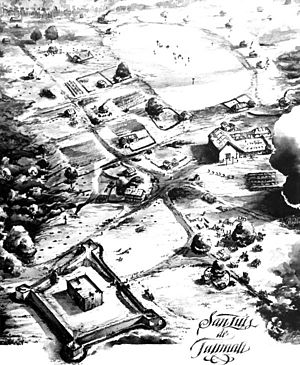Mission San Luis de Apalachee facts for kids
|
San Luis De Talimali (formerly San Luis de Apalache)
|
|
 |
|
| Location | Leon County, Florida, USA |
|---|---|
| Nearest city | Tallahassee, Florida |
| NRHP reference No. | 66000266 |
Quick facts for kids Significant dates |
|
| Added to NRHP | October 15, 1966 |
| Designated NHL | October 15, 1966 |
Mission San Luis de Apalachee (also known as San Luis de Talimali) was a Spanish Franciscan mission built in 1633. It was located in the Florida Panhandle, about two miles west of today's Florida Capitol Building in Tallahassee. The mission was part of Spain's plan to colonize Florida and teach Christianity to the Timucua and Apalachee Native Americans.
The mission was used until 1704. At that time, it was emptied and destroyed. This was done to stop Creek Indians and people from South Carolina from using it. The place where the mission stood was named a U.S. National Historic Landmark on October 15, 1966. In 1996, a project started to rebuild some of the mission's structures. This was based on what archaeologists and historians found.
Contents
Apalachee People and Their Land
The Apalachee Province was a very strong and rich area in Florida. The Apalachee people were the most advanced Native Americans in Florida. They were part of the Mississippian culture of mound builders. They had good ways of running their communities and religious systems.
First Meetings with Europeans
In 1528, Pánfilo de Narváez was the first European to visit the Apalachee land. He set up camp near what is now St. Marks, Florida. Later, in 1539, Hernando de Soto spent the winter in Anhaica, which is now Tallahassee. He celebrated the first Christmas in North America there.
In 1607, some Apalachee people asked for friars (religious teachers). The first friars visited in 1608. In 1612, the Apalachee formally asked for a mission, but Spain did not agree at that time. By 1625, the Apalachee began sending food to St. Augustine. This was a major Spanish city in Florida. Spain needed the Apalachee land because it was very fertile and had many people who could help provide food and labor for St. Augustine.
Building the Mission
In 1633, Pedro Muñoz and Francisco Martínez officially started the mission in Apalachee Province. By 1638, a few Spanish soldiers came to explore the area and buy food for the governor. There is no sign that a fort was built then.
From 1645 to 1651, soldiers lived on the eastern edge of Apalachee Province. In 1656, Spanish leaders decided to build their western capital on a high hill. This was for better protection. The people living in the old San Luis area moved to the new site at Spain's request.
The number of soldiers grew to 12. The chief of San Luis promised to build a strong blockhouse for them. A blockhouse is a small, strong fort. Even though the governor wanted to build a bigger fort, the Apalachee people did not want it. So, the project was stopped for many years. The blockhouse was called a "fortified country house" in 1675. From 1656 to 1680, the number of soldiers changed between 12, 19, and 25.
The Apalachee people were very good farmers. They grew much of the food for San Luis. They also grew food to send to places like St. Augustine and Havana.
The first deputy governor, Claudio Luis de Florencia, arrived in 1645. He lived with his family at old San Luis. By 1675, more than 1,400 Spanish and Apalachee people lived under San Luis's rule. There were not many Spanish women. So, Spanish soldiers often married Native American women. This helped to spread Christianity and Spanish ways of life. While other Apalachee missions lost people, San Luis's population grew.
Mission Buildings and Their Use
The buildings at San Luis included homes for both Spanish and Apalachee people. There was also a Franciscan Church and a Spanish fort. The Native American Council House was one of the largest Native American buildings in the southeastern United States at that time. It could hold 2,000 to 3,000 people.
In the early 1680s, the blockhouse was taken down. A temporary barracks (soldiers' living area) was put up. The number of soldiers then grew to 40, and sometimes more for special trips.
In 1688, a fort called San Marcos de Apalache was built at St. Marks, Florida. Its wood came from San Luis. But the fort was not finished because the workers were sent to build another fort in Apalachicola country in 1689. This new fort had 20 soldiers and 20 Apalachee warriors.
From 1695 to 1697, a new blockhouse was built at San Luis. By April 1696, it was almost finished. Work stopped for spring planting. In 1698, the Apalachee people were upset because Spaniards took some of their homes and land. Spaniards also took wood meant for church repairs and made Native Americans build houses for them.
In October 1702, after a defeat by Spanish-Apalachee forces, work began to turn the blockhouse into a proper fort. It would have a strong fence (palisade), walls (parapets), and a dry ditch (moat). It was likely finished in 1703, even with a bad sickness going around.
By the end of July 1704, English and Creek raiders attacked the area. The Spanish soldiers, whose numbers were now much smaller, destroyed the fort. They then left for St. Augustine. This was done to prevent the raiders from using the fort.
Since 1996, architects have been rebuilding many of the mission's structures. They use archaeological and historical information to guess how the buildings originally looked. Reconstructed buildings include the Church, the Convento (friars' living area), the Council House, the Chief's House, the Fort and Blockhouse, and a typical Spanish House.
Images for kids
See also
 In Spanish: San Luis de Apalache para niños
In Spanish: San Luis de Apalache para niños





